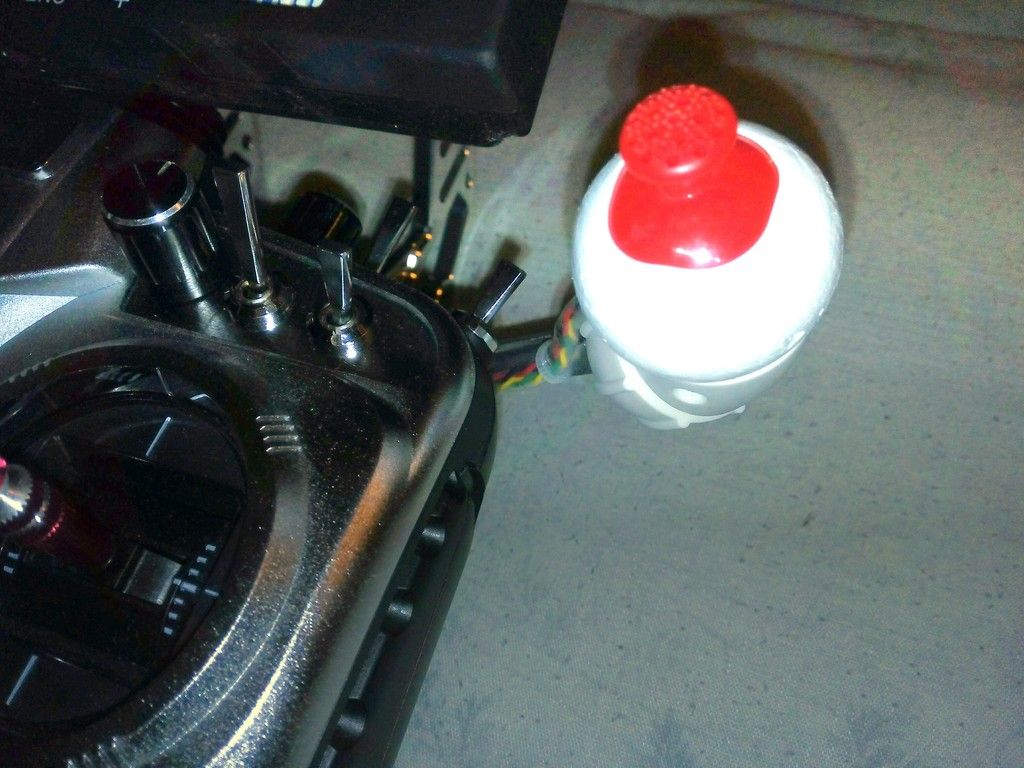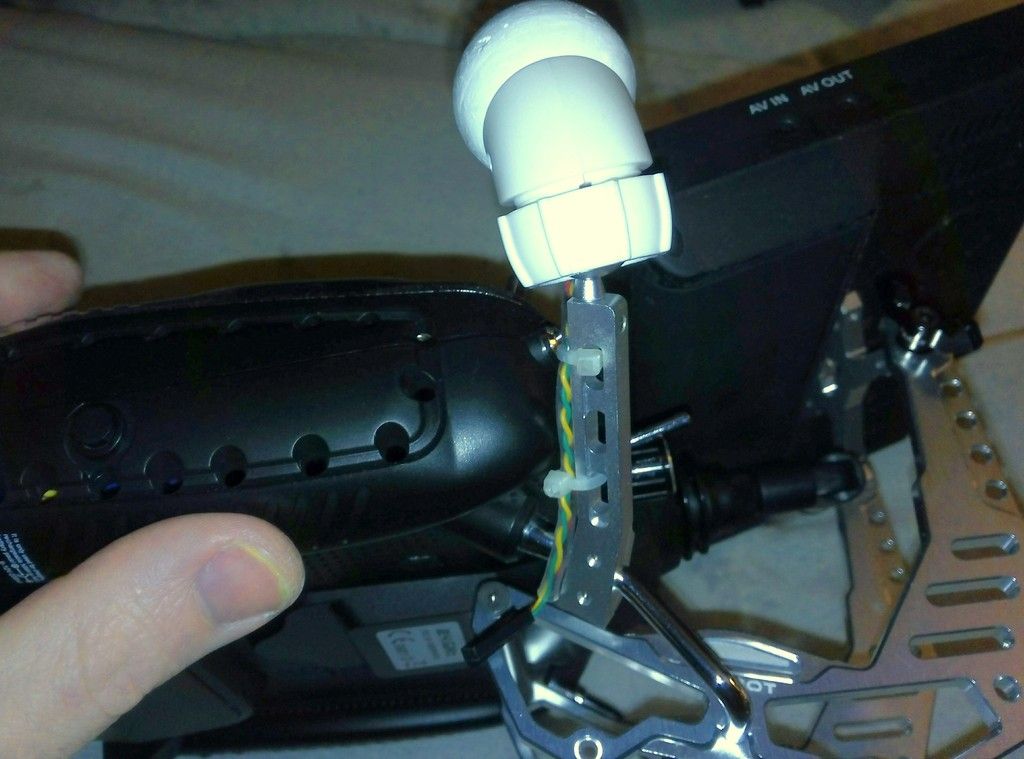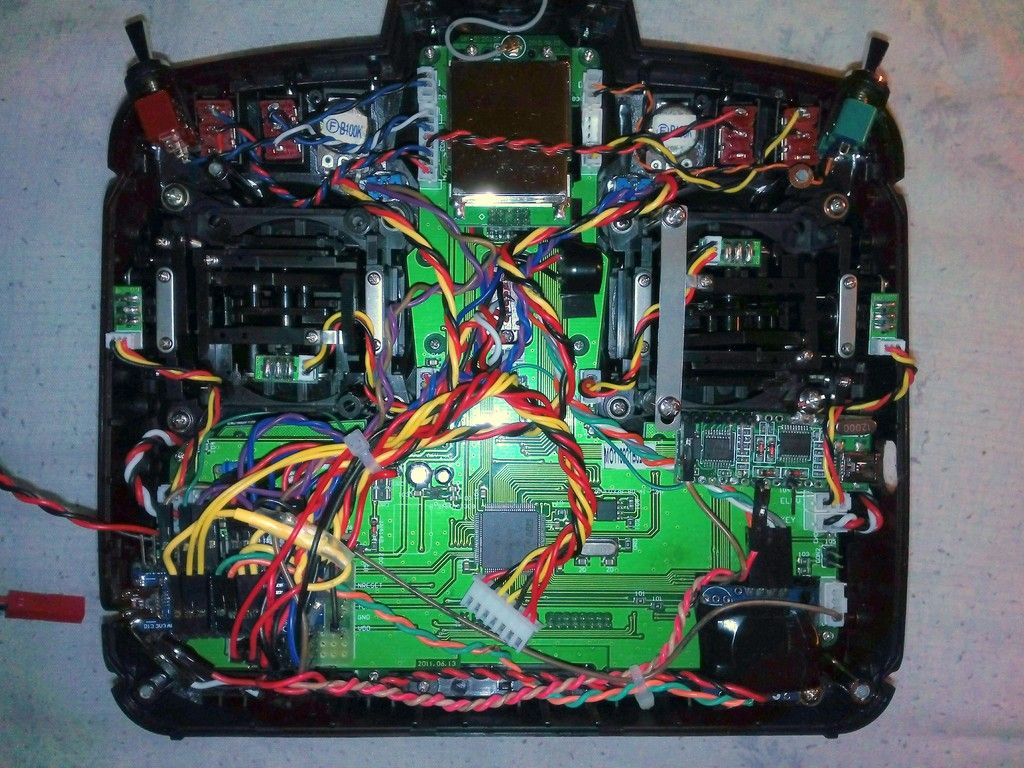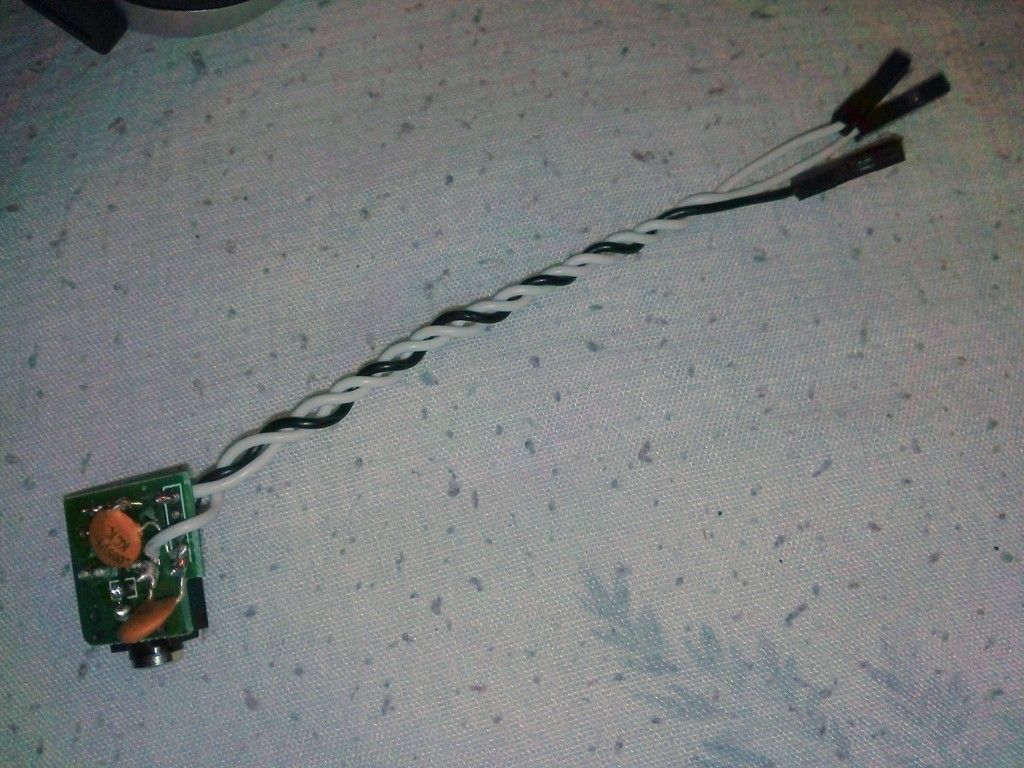Extra inputs for Devo Tx's
- FDR
-
- Offline
mwm wrote: Instructions for getting the arduino ide working on the maple mini are in the Arduino_STM32 wiki: github.com/rogerclarkmelbourne/Arduino_STM32/wiki
Those worked for me with the "minimum system development board", which is basically a maple mini with boot jumpers instead of a user button. I've switched to using my deviationTx build environment instead, and am evaluating RTOS choices.
I ordered two of them too, but I haven't received them yet.
I also plan to use our deviation build environment, that's the reason I ordered the STM32 variants.
Do you already have a working setup for them?
I think I will stick with the OS free codebase with the interrupts, but I need to take a deeper look into the code to get started...
Please Log in or Create an account to join the conversation.
- mwm
-
Topic Author
- Offline
The serial interface is a bit of a kludge, as it needs to be connected to pins PA9 and PA10 for usart1, but I have a number of USB<->Serial tools for Arduino work so started with that. The other options are preferred since they let you debug code running on the µ-controller. Cheap st-link clones cost a bit more than these stick boards. A lot of the STM discovery boards have an embedded ST-LINK device that can be jumpered to work with other devices. Those can be had for just a bit more than the cost of a clone ST-LINK, and a lot less than a non-clone ST-LINK device, so I ordered the F4Discovery board.
Do not ask me questions via PM. Ask in the forums, where I'll answer if I can.
My remotely piloted vehicle ("drone") is a yacht.
Please Log in or Create an account to join the conversation.
- FDR
-
- Offline
I thought they can be programmed through the USB with the standard STM DfuSe program...
I only have this AVR programmer:
www.hobbyking.com/hobbyking/store/uh_vie....asp?idProduct=27990
Please Log in or Create an account to join the conversation.
- mwm
-
Topic Author
- Offline
It won't work with dfuse out of the box, or at least dfu-util doesn't see it as a dfu capable device. For that matter, it doesn't show up as a USB device at all. There are a number of dfu bootloaders available for that work like the Arduino stuff: they occupy the first ~2K of FLASH, you compile code for that offset address, and they'll load and start it. There's even one in the libopencm3 examples that works pretty much out of the box.
You sure you don't have some kind of USB<->Serial programmer? Those are needed for a lot of the older/smaller Arduinos. Worst comes to worst, you could use an Arduino script that echo'd bytes between the USB port serial line and a softserial instance.
Do not ask me questions via PM. Ask in the forums, where I'll answer if I can.
My remotely piloted vehicle ("drone") is a yacht.
Please Log in or Create an account to join the conversation.
- Richard96816
-
- Offline
- Posts: 208
Please Log in or Create an account to join the conversation.
- FDR
-
- Offline
I have already ordered a dirt cheep ST-LINK clone:
www.ebay.com/itm/ST-Link-V2-Shell-STM8-S...?hash=item5672f1c7a5
It is on a slow boat, so I will have quite a long time to prepare.
Please Log in or Create an account to join the conversation.
- mwm
-
Topic Author
- Offline
Richard96816 wrote: Getting started with STM32 built-in USB DFU Bootloader
The first thing they say is "Check for eligible STM32 products supporting this function in table 1 of application note AN3156." That application note is at www.st.com/web/en/resource/technical/doc..._note/CD00264379.pdf
The STM32F103 - used on the "minimum system development board", the similar maple mini clones and the Devo Tx's - isn't listed in that table. You can go downscale to the STM32F0 or upscale to the STM32F105, STM31F105 or STM23F3 or STM32F4 (Cortex M-4's instead of M3's in the F1).
Do not ask me questions via PM. Ask in the forums, where I'll answer if I can.
My remotely piloted vehicle ("drone") is a yacht.
Please Log in or Create an account to join the conversation.
- Richard96816
-
- Offline
- Posts: 208
mwm wrote:
Richard96816 wrote: Getting started with STM32 built-in USB DFU Bootloader
The first thing they say is "Check for eligible STM32 products supporting this function in table 1 of application note AN3156." That application note is at www.st.com/web/en/resource/technical/doc..._note/CD00264379.pdf
The STM32F103 - used on the "minimum system development board", the similar maple mini clones and the Devo Tx's - isn't listed in that table. You can go downscale to the STM32F0 or upscale to the STM32F105, STM31F105 or STM23F3 or STM32F4 (Cortex M-4's instead of M3's in the F1).
Maybe I've been reading too many Chinglish manuals lately. But the various app-notes that I've read all seem to say the whole STM32F1 'series' currently includes the ROM USB bootloader. A few earlier date coded chips (not F103s) were apparently not supported. Some in the F1 series are singled out for working differently, but they all seem to include the bootloader. I think.
Guess I better unwrap some of the boards I've been receiving recently and try them ... I have wondered why the Devos all seem to have 'unnecessary' pinouts for STlink connections.
www.st.com/web/en/resource/technical/doc..._note/CD00167594.pdf
Please Log in or Create an account to join the conversation.
- FDR
-
- Offline
Furthermore it would need to use the BOOT0 pin, which (according to the low res picture on seller's site) is unconnected.
I had hoped that it is connected to the jumpers in order t use the USB loader, but it seems it's not the case, so I ordered an ST-LINK clone...
EDIT: BTW the datasheet of the F103 doesn't mention the DFU mode in the boot section, while the others on the compatible list, like the F105 do..
Please Log in or Create an account to join the conversation.
- mwm
-
Topic Author
- Offline
Richard96816 wrote: Maybe I've been reading too many Chinglish manuals lately. But the various app-notes that I've read all seem to say the whole STM32F1 'series' currently includes the ROM USB bootloader. A few earlier date coded chips (not F103s) were apparently not supported. Some in the F1 series are singled out for working differently, but they all seem to include the bootloader. I think.
Guess I better unwrap some of the boards I've been receiving recently and try them ... I have wondered why the Devos all seem to have 'unnecessary' pinouts for STlink connections.
www.st.com/web/en/resource/technical/doc..._note/CD00167594.pdf
By my reading, they all have boot loaders, but exactly what the boot loader does depends on the µ-controller in question. The F103 chips only load via USART1. The F105 and F107 chips can load via USART1, USART2 and DFU.
AFAIK, the maple mini has a "user" button and BOOT0 isn't connected to anything. The maple boot loader (which is running from flash, not replacing the USART1 boot loader) checks for that to load to flash beyond it via DFU. The minimum system development board that I have is missing the user button, and instead has jumpers for BOOT0 and BOOT1. BOOT0 causes the chip to jump to the on-chip boot loader to load via USART1. Not sure how ST-LINK works in that - my st-link is still on the way. BOOT1 is supposed to make it load code to RAM instead of FLASH and run it, but I've not been able to get that to work. BOOT1 is also connected to an IO pin, so you get a user jumper instead of the button. I think I agree with the designer that the two boot jumpers is better for development than a user button.
Notes on the minimum system development board: check the forums at stm32duino.com - they have links to what little English information there is, including the canonical pin diagram. They also call them the "red pill" and "blue pill" boards, which I'm going to use 'cause it's easier to type. Finally, I've tweaked some of the libopencm3 examples to work on them; let me know if you're interested in them, but they are pretty straightforward - mostly moving the led pin to the right place.
Do not ask me questions via PM. Ask in the forums, where I'll answer if I can.
My remotely piloted vehicle ("drone") is a yacht.
Please Log in or Create an account to join the conversation.
- Richard96816
-
- Offline
- Posts: 208
www.deviationtx.com/forum/6-general-disc...-7e-bootloader#34250
The ST-Link is more powerful than the USB boot loader anyway, and not too expensive. So good enough. My 'generic board with yellow pins' does seem to have the USB ROM loader. When I enable Boot0 it shows up on USB, though my Linux box doesn't yet want to connect to it. There are posts of others successfully flashing them from Windows.
www.sunspot.co.uk/Projects/Arduino/STM32/STM32.html
As you say, there appear to be many paths to, and flavors of, boot loaders on the STM32s.
(I still have a suspicion that a 'bricked' Devo can be restored with a USB cable and a couple jumpers.)
Please Log in or Create an account to join the conversation.
- Epyon
-
- Offline
- Posts: 57


A cheap cellphone mount plus a hacked microquad controller equals camera gimbal.
Haven't done much else with my Devos. Got a little discouraged after buttoning up the Devo 8, powering it up,.................and realizing that I cracked the OLED display. Oops
Please Log in or Create an account to join the conversation.
- mwm
-
Topic Author
- Offline
Richard96816 wrote: PB's post on re-flashing the Devo 7e boot loader will probably work with ST-Link. (Worked fine for my 7e.)
www.deviationtx.com/forum/6-general-disc...-7e-bootloader#34250
Just a warning in case it's not obvious: the devo boot loader has odd additions to it, so that it only works with the devo firmware (or PB's thing). So you may not want to use it as a boot loader on anything else.
On the other hand, I've been thinking about replacing the boot loader on one of my devo's so I can use the standard dfu to load files. Haven't gotten beyond just thinking about it, though.
Do not ask me questions via PM. Ask in the forums, where I'll answer if I can.
My remotely piloted vehicle ("drone") is a yacht.
Please Log in or Create an account to join the conversation.
- mwm
-
Topic Author
- Offline
And after mucking about with Arduinos and this with stm32flash, the ability to run code on it in gdb, complete with breakpoints and reading/writing memory is going to be a big help. I'll have to see if I can get that functionality working on a Devo!
Do not ask me questions via PM. Ask in the forums, where I'll answer if I can.
My remotely piloted vehicle ("drone") is a yacht.
Please Log in or Create an account to join the conversation.
- Epyon
-
- Offline
- Posts: 57
Ended up getting a WT588D-U .
It's working a little flaky at the moment. Running it in 1-wire "serial" (bitbang). I can't get it to trigger consistently. Tried in 3-wire mode as well, and both using the onboard reset and busy pins. Next I'm going to try powering it from an Arduino IO pin and power-cycling it after each sound (it starts up quick enough).


For the output, I just re-purposed the DSC jack as a headphone output. It's hooked to my PC speakers in the vid. I've got a couple sets of small powered speakers that I can work at least one of inside the Devo. Need to figure out a volume control though. The board is supposed to have a serial-controllable volume, but I've yet to get it to work.
The audio quality is crap. This module sucks...........
Please Log in or Create an account to join the conversation.
- Cereal_Killer
-
- Offline
Epyon wrote: Sound module!!..................................................sort of.......
Ended up getting a WT588D-U .
It's working a little flaky at the moment. Running it in 1-wire "serial" (bitbang). I can't get it to trigger consistently. Tried in 3-wire mode as well, and both using the onboard reset and busy pins. Next I'm going to try powering it from an Arduino IO pin and power-cycling it after each sound (it starts up quick enough). ]
For the output, I just re-purposed the DSC jack as a headphone output. It's hooked to my PC speakers in the vid. I've got a couple sets of small powered speakers that I can work at least one of inside the Devo. Need to figure out a volume control though. The board is supposed to have a serial-controllable volume, but I've yet to get it to work.
The audio quality is crap. This module sucks...........
Off topic but where can I read about the OLED / get code for it?
Progress looks great!!
Taranis X9E | DEVO 10 | Devo U7E | Taranis Q7
What I do in real life: rivergoequestrian.com/
Please Log in or Create an account to join the conversation.
- Epyon
-
- Offline
- Posts: 57
Cereal_Killer wrote: Off topic but where can I read about the OLED / get code for it?
Just search for "ssd1306", that's the driver chip most used. You can get displays that run I2c and/or SPI. Depending on the particular display (there are many, many clones) you may need to change the I2c address.
I'm using a library from Adafruit. Makes it real easy. learn.adafruit.com/monochrome-oled-break...library-and-examples
The library will work as-is with the 128x64 or 128x32 displays, I2C or SPI. I've also got a 64x48 (tiny!) display to run off the library by altering it a little. Also dabbled with the U8glib library.
Please Log in or Create an account to join the conversation.
- Cereal_Killer
-
- Offline
Taranis X9E | DEVO 10 | Devo U7E | Taranis Q7
What I do in real life: rivergoequestrian.com/
Please Log in or Create an account to join the conversation.
- Epyon
-
- Offline
- Posts: 57
Cereal_Killer wrote: Ok yes I've used those 128x64's before on multiwii. How do you get it to know what mode it's in tho? Does it work with the built in switches or just the arduino controlled PPM add-on switches? If it only works based on the added in channels I understand, if it's somehow reading the factory switches I don't get it...
Yeah, just reading the Arduino-connected switches ATM, but hope to read the Devo's piezo output to trigger additional sounds. Basically setting a Timer alarm on the Devo activated by a switch, then reading the output pulse (alarm tones need set unique enough to differentiate). I took a crack at it a couple nights back, but failed, could've been the insomnia though.
Please Log in or Create an account to join the conversation.
- mwm
-
Topic Author
- Offline
rc.mired.org/2015/10/rc-blog-entry-on-my-programming-blog.html
Do not ask me questions via PM. Ask in the forums, where I'll answer if I can.
My remotely piloted vehicle ("drone") is a yacht.
Please Log in or Create an account to join the conversation.
-
Home

-
Forum

-
Development

-
Development

- Extra inputs for Devo Tx's
